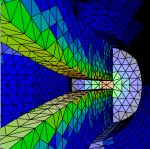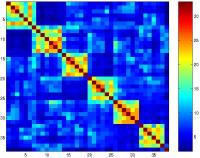HSS Preconditioning for the Computation of Electromagnetic Fields
| Working Group: | Former WG Numerics |
| Leadership: | Prof. Dr. Angelika Bunse-Gerstner (E-Mail: bunse-gerstner@math.uni-bremen.de ) |
| Processor: | Dr. Ignacio Gutiérrez-Cañas |
| Project partner: | EADS Deutschland GmbH, Betriebsstätte Bremen |
| Time period: | 01.06.2000 - 28.02.2006 |

In furtherance of the work carried out in a research project undertaken with our partner EADS in Bremen, the Numerical Computation working group is addressing the rapid computation of the electric field around perfectly conducting metal objects such as aeroplanes or satellites and transmitters.
This problem is formulated mathematically using the so-called EFIE (electric field integral equation), whose discretisation leads to a system of linear equations of an extremely large dimension with a dense matrix of coefficients which is frequently ill-conditioned. Owing to the exceedingly large number of unknowns, between 104 and 107 for problems which occur in practice, it is no longer possible to set up the system matrix in its entirety, only the near field part can be explicitly stored. Iterative methods must be used to solve the system of linear equations, said methods requiring a matrix vector product at each step of the iteration. For the far field part, this is realised with the aid of the fast multipole method (FMM) which is accelerated by a multilevel approach.
In the field of application one uses primarily GMRES variants as the iterative method to solve the systems of linear equations of the EFIE. Satisfactory preconditioners have not yet been found for these problems, however. One reason is that essentially only information from the near field matrix can be used to construct a preconditioner. For large dimensions, this near field matrix is still only a very small part of the whole matrix, however, some 1 percent for dimensions of the order of magnitude of 107, for example. Preconditioners developed so far accordingly also demonstrate a strong reduction of the convergence acceleration with increasing dimension.
The FMM approach means that the system matrices have a very special rank structure in the submatrices. They are H2 matrices [?, ?, ?], or hierarchical semi-separable (HSS) matrices [?, ?, ?, ?, ?, ?]. This project deals with the development of preconditioners with a hierarchical semiseparable structure which can only be obtained from information from the near field matrix. On the one hand, the prescribed HSS structure will make it possible to solve systems of equations with these matrices very easily. On the other, the HSS structure will enable a better approximation to the system matrix to be achieved for the purposes of preconditioning [?, ?]. In the experimental analyses carried out to date, these approaches lead to a convergence behaviour which is much more favourable than the preconditioners being used at the moment.
The practical work necessary for these analyses requires intensive utilisation of computers. It requires a great deal of computer power and memory. At present, a considerable number of the computations are being done on a computer belonging to the Alfred Wegener Institute in Bremerhaven, an IBM Reagatta with 32 processors. The preconditioning of the system of equations requires a vast memory which cannot be made available using standard workstations. At present, the programs are constructed sequentially and need around 5 hours of computer time. We plan to utilise parallel solvers.


